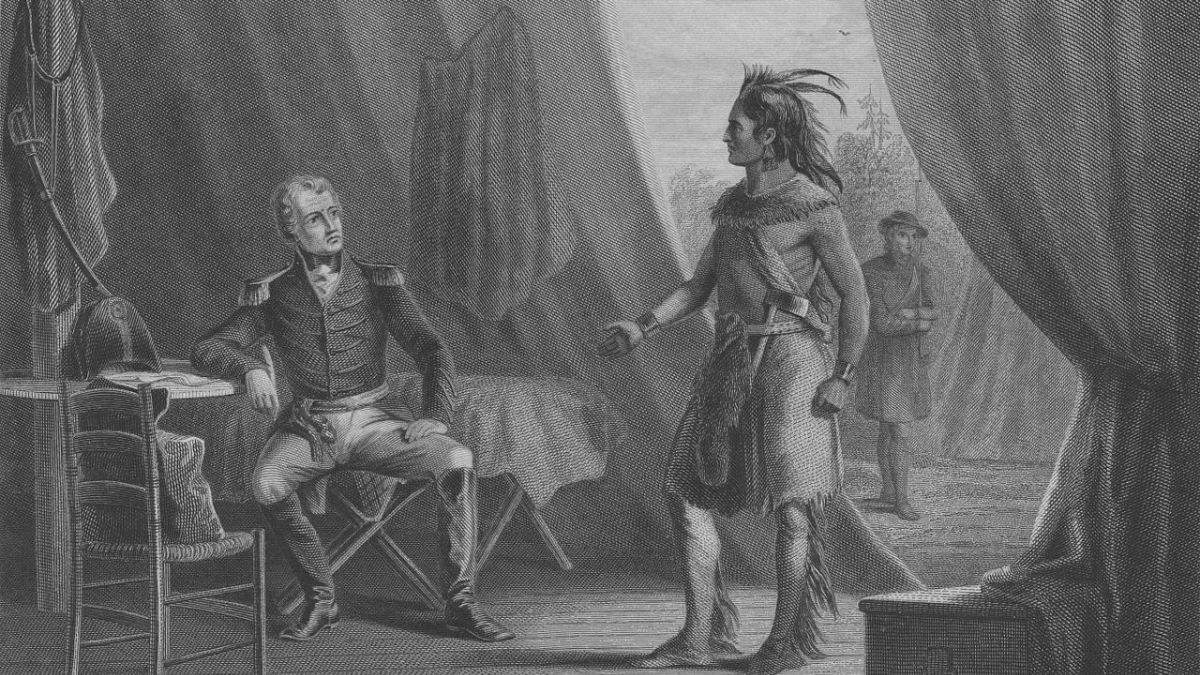Turner’s Fort, situated along the Alabama River in Clarke County, is a historical landmark brimming with untold stories.
This fort was vital during the Creek War of 1813-1814, offering settlers a crucial defense against Red Stick attacks.
Abner Turner established it as a stronghold amidst escalating tensions between American colonists and the Creek Nation.
The fort’s robust design and strategic location underscored its significance in early 19th-century conflicts.
Through its intricate structural features and deep cultural interactions, Turner’s Fort is a powerful reminder of the region’s turbulent past and resilient spirit.
History of Turner’s Fort
Turner’s Fort, located along the Alabama River in Clarke County, played a significant role during the Creek War of 1813 and 1814.
The fort’s namesake, Abner Turner, established it near Turkey Town to protect settlers from Red Stick attacks.
During the War of 1812, the tension between American settlers and the Creek Nation escalated.
The Creek War, part of the larger conflict, saw fierce battles and numerous skirmishes.
Turner’s Fort provided a critical defense spot during these times.
Its construction was driven by the need for security and played a key part in the defense strategy for the area.
According to History of Alabama and Dictionary of Alabama Biography, the fort witnessed several significant confrontations.
Records from this period detail the strategic movements and defensive measures those at Turner’s Fort took.
This site serves as a reminder of the turbulent early 19th-century conflicts that shaped the region.
Structural Features
Turner’s Fort features thoughtful design elements, incorporating defensive strategies and connections to neighboring Fort Easley.
Stockade Design
Turner’s Fort’s central feature is its stockade made of robust split pine logs. This stockade forms a rectangular enclosure, essential for defense.
The structure is reinforced with vertically placed bonded logs, known as palisades, which ensure the stockade’s strength.
The compact design minimizes gaps, preventing infiltration during attacks.
Two blockhouses are stationed at opposite corners. These blockhouses are elevated, providing vantage points.
Their construction allows for efficient, wide-ranging surveillance. The presence of these blockhouses underpins the defensive intent.
The Turner Corn Crib is a key component within the enclosure. This storage facility remains protected, ensuring essential supplies are safe during sieges.
Defensive Strategies
The architecture of Turner’s Fort focuses on defense. The fence, with its split pine logs, provides a robust first line of defense.
Its high, tightly placed palisades form a barrier against external threats.
Blockhouses, positioned at critical points, serve dual purposes. They act as lookout towers and defensive strongholds from which defenders can monitor and repel attacks.
Inside the fort, structures are arranged to maximize defensive capability.
The internal layout allows for strategic movement. Paths and smaller buildings ensure defenders have clear lines of sight.
Entrances are narrow and fortified, making it difficult for intruders.
This, combined with internal pathways, ensures defenders have strategic advantages during confrontations.
Fort Easley Connection
Turner’s Fort maintains a significant relationship with Fort Easley. The connection serves strategic and communicative purposes.
Positioned within a day’s travel, Turner’s Fort and Fort Easley can support each other effectively.
Information relay systems between both forts include signal fires and messengers. These ensure swift communication.
This connection bolsters their combined defensive capabilities.
Joint exercises and coordinated defense strategies enhance mutual readiness.
These fortified ties enable the forts to present a united front against potential threats.
Turner’s Fort, with its meticulous design and strategic alliances, embodies a well-rounded defensive structure.
Cultural Significance
Turner’s Fort holds a unique place in history due to its interactions with Indigenous tribes, its impact on community life, and its enduring historical legacy.
Relations with Indigenous Tribes

Turner’s Fort was crucial during the Creek War, primarily interacting with the Choctaws and other local tribes.
Located near the Choctaw Village and Turkey Town, it often served as a meeting point for negotiations and trade.
These interactions were not always peaceful; conflicts were frequent, yet essential cultural exchanges occurred.
The Choctaws, for instance, traded goods and shared agricultural practices with the settlers, influencing local economies and diets.
Turner’s Fort thus became a melting pot of indigenous and settler cultures, profoundly shaping the region’s history.
Community and Daily Life
The daily life at Turner’s Fort revolved around agriculture, defense, and community gatherings.
The fort was central to the West Bend Community, providing a haven during conflicts.
Camp Meetings were significant social and religious events where settlers gathered for worship and communal activities.
These meetings fostered a sense of unity and played a pivotal role in community bonding.
Women often engaged in weaving, cooking, and childcare, while men focused on farming and fort maintenance.
The fort’s structure and daily routines reflected the community’s need for security and social cohesion.
Historical Legacy
The historical legacy of Turner’s Fort is preserved through institutions like the Clarke County Historical Museum.
This site serves as a reminder of the fort’s strategic importance and impact on regional history.
The fort is frequently mentioned in historical records, notably the “Dead Towns of Alabama” and the “Encyclopedia of Historic Forts,” highlighting its relevance.
Although the fort no longer stands, its influence remains evident in Clarke County’s cultural and historical landscape.
Local historians and educators use this legacy to teach about the interactions between settlers and Indigenous tribes, ensuring that Turner’s Fort remains remembered.
Key Individuals and Roles
This section explores pivotal figures and their roles in the context of Turner’s Fort. Key individuals include Abner Turner, Tandy Walker, and Mrs. Crawley, whose contributions shaped various aspects of the fort’s history.
Leaders and Figures
Abner Turner played a crucial role in establishing Turner’s Fort. As a leader during the Creek War, Turner demonstrated strategic prowess and fortitude.
His leadership helped secure the fort as a haven for settlers.
Turner’s actions and decisions were significant in navigating the complex dynamics of the conflict.
His role extended to overseeing fort defenses and coordinating with other military leaders, ensuring the security and well-being of the community.
Tandy Walker, another key figure, was known for his leadership and resourcefulness.
A prominent pioneer, Walker worked closely with Turner to manage the fort’s operations.
His contributions included organizing defenses, managing supplies, and connecting with other settlements.
Walker’s efforts were instrumental in maintaining the operational integrity of Turner’s Fort during turbulent times.
Mrs. Crawley managed essential support roles within the community.
Her efforts in organizing supplies and caring for the wounded were vital to the fort’s resilience.
Crawley’s work, often happening behind the scenes, was essential for the daily functioning of the fort, ensuring sustenance and morale remained high.
Interpreters and Diplomacy
Interpreters at Turner’s Fort were pivotal in facilitating communication and diplomacy.
They played essential roles in negotiations with ally and adversary Native American tribes.
Skilled interpreters were critical in understanding and conveying nuanced messages accurately.
Their work reduced misunderstandings and helped to forge strategic alliances.
These interpreters were often the unsung heroes, bridging cultural divides.
Their ability to communicate effectively and diplomatically was a key asset.
Their contributions can’t be understated in conflict resolution and establishing peaceful coexistence.
Diplomacy efforts included negotiating safe passages and trade agreements.
Counsel from these interpreters guided leaders in making informed decisions.
Their insights were crucial during critical negotiations, often determining the success of diplomatic engagements.
Geographic Context
Turner’s Fort is in Clarke County, a region known for its rich history and natural beauty. This fort played a significant role in the development of the surrounding communities.
Clarke County is nestled along the Alabama River, providing essential resources and enabling transportation and trade.
A key highlight of the area is the proximity to St. Stephens, an early Alabama settlement and the first territorial capital.
The West Bend Community lies nearby, characterized by its strong ties to the fort and contributions to local culture.
The area around Turner’s Fort is lush and green, featuring rolling hills and dense forests.
The river’s proximity has fostered diverse wildlife and rich soil, ideal for agriculture.
These geographic features have greatly influenced the growth and development of the communities surrounding Turner’s Fort.
Explore More: 19 Historic Forts in Alabama
Primary Sources and References
This section explores the foundational materials that provide insight into Turner’s Fort’s history and significance. These sources include literature and maps documenting its historical context and geographical placement.
Literature and Documentation
Research on Turner’s Fort often involves consulting several key texts. Dead Towns of Alabama by W. Stuart Harris offers detailed information about the now-defunct fort.
The Encyclopedia of Historic Forts by Robert L. Dorman is essential for understanding the broader network of forts.
It includes specific entries on Turner’s Fort, offering context for its establishment and function.
Thomas M. Owen’s History of Alabama and Dictionary of Alabama Biography provide another layer of insight.
This work contains biographical sketches and historical narratives and helps situate Turner’s Fort within Alabama’s broader historical panorama.
Maps and Visual Aids
Maps are crucial for understanding the strategic significance of Turner’s Fort.
Historic maps from the Library of Congress often feature the fort, showing its placement relative to key geographical features of the time.
Topographic maps from the period highlight the fort’s defensive advantages.
Visual aids such as reconstructed drawings offer a glimpse into daily life and structural layouts.
Historical atlases, often available in local archives, provide additional context.
These maps are frequently supported by modern techniques like GIS, helping researchers visualize historical data with greater accuracy.
Explore More: Army Forts in Alabama
Military Engagements
Turner’s Fort saw significant military activity during the War of 1812 and the Creek War, mainly through the Red Stick Attacks and Andrew Jackson’s Campaigns in the Mississippi Territory.
Creek War Battles
During the Creek War, Turner’s Fort became a focal point for skirmishes involving settlers and Red Stick factions.
The Red Sticks, a militant group within the Creek Nation, aimed to resist American expansion.
In 1813, they launched numerous assaults on forts, including Turner’s Fort, leading to high casualties.
The Battle of Burnt Corn Creek and Fort Mims Massacre were key events that escalated the conflict.
These attacks prompted urgent military responses from the settlers to defend their territories and suppress the uprisings.
The volatile environment meant constant vigilance was necessary for those stationed at or taking refuge in Turner’s Fort.
Andrew Jackson’s Campaign
Andrew Jackson was pivotal in the military engagements involving Turner’s Fort.
His aggressive campaigns targeted the Creek resistance during the same period.
Jackson swiftly mobilized troops to reinforce fort defenses and push back the Red Sticks.
Significant battles included the Battle of Horseshoe Bend, where Jackson’s forces decisively defeated the Creek warriors.
This victory was crucial in dismantling the Red Stick military power and securing the Mississippi Territory.
His effective strategies reinforced Turner’s Fort and expanded American influence, paving the way for further frontier settlements.
Jackson’s leadership in these campaigns exemplified the strategic military efforts to dominate the region and pacify hostile factions.

Cory is a website owner and content creator who enjoys fishing, history, coin collecting, and sports, among other hobbies. He is a husband and father of four.
Romans 15:4 For whatever was written in former days was written for our instruction, that through endurance and through the encouragement of the Scriptures we might have hope.

